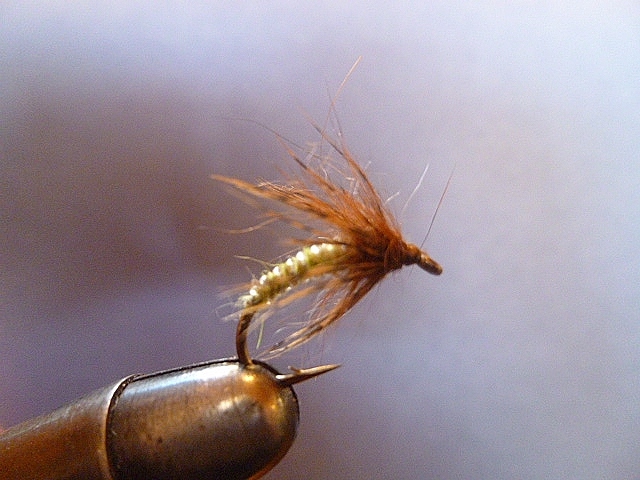On many streams grannom
caddis (Brachycentrus) are the first reliable hatch of the season. On some, this insect might
be the most productive hatch of the year. In NE Washington
state, grannom usually start to appear toward the end of April & emerge well
into June & sometimes July, the strongest emergence usually around the end of May. Of the several
species of caddis that are important hatches in my neighborhood, grannom spurs
the best dryfly action, & that possibly due to their habit of migrating to
& emerging from shallow water, where the pupae emerge swiftly, often times forcing
trout to fill the void with the more prolific adult egg-layers, which are coincident. Nonetheless, trout prefer the wingless pupae & will eat them readily when an opportunity arises. In in my
own experience, the emerging pupa is the most productive stage of grannom to imitate
& fish.
Nymphs will generally be #12-#14; & the pattern given here, tied in #10-#18 will cover a lot of caddis species besides grannom, East & West. I use this same pattern to cover spotted sedge, a more prolific & longer-lasting caddis than grannom, on my homewater. Tied in a #10 this one will cover great gray spotted sedge, & also the lake-dwelling traveling sedge. I think this version represents a fundamental soft-hackle sedge design that will turn the trick as well as any I’ve tried.
Because trout always show a preference, it is good to carry more than one version of grannom. I use the same basic tie, which gives me the profile I think simulates the pupa well, & then apply several different abdomen materials to that basic tie.
Nymphs will generally be #12-#14; & the pattern given here, tied in #10-#18 will cover a lot of caddis species besides grannom, East & West. I use this same pattern to cover spotted sedge, a more prolific & longer-lasting caddis than grannom, on my homewater. Tied in a #10 this one will cover great gray spotted sedge, & also the lake-dwelling traveling sedge. I think this version represents a fundamental soft-hackle sedge design that will turn the trick as well as any I’ve tried.
Because trout always show a preference, it is good to carry more than one version of grannom. I use the same basic tie, which gives me the profile I think simulates the pupa well, & then apply several different abdomen materials to that basic tie.
Bunny Grannom Pupa
Hook: #12-#14
Daiichi 1150 caddis style
Thread: Camel
or brown
Rib: Round
silver tinsel – I use size D metallic rod wrapping thread, five turns over the
abdomen
Abdomen: Olive
rabbit dubbing (you can add a pinch of chartreuse to brighten it); olive, standard tubing over silver tinsel; green rubber band; clear lace over olive floss or yarn
Thorax: Light-brown hare’s mask – 2 turns ahead of the abdomen
Hackle: Brahma
hen (you can substitute brown partridge or grouse)
Head: Light-brown hare's mask with guard hairs in - about four turns in a dubbing loop of the tying thread, actually a continuation of the thorax - & finish.
Head: Light-brown hare's mask with guard hairs in - about four turns in a dubbing loop of the tying thread, actually a continuation of the thorax - & finish.
 |
| Rubber Band Grannom |
 |
| Clear lace over olive yarn |
 |
| Tubing over silver floss abdomen |
Flyfish NE Washington with Steven Bird: http://ucflyfishing.blogspot.com

